Hyundai Accent 2016 User Guide
Manufacturer: HYUNDAI, Model Year: 2016, Model line: Accent, Model: Hyundai Accent 2016Pages: 456, PDF Size: 16.41 MB
Page 11 of 456
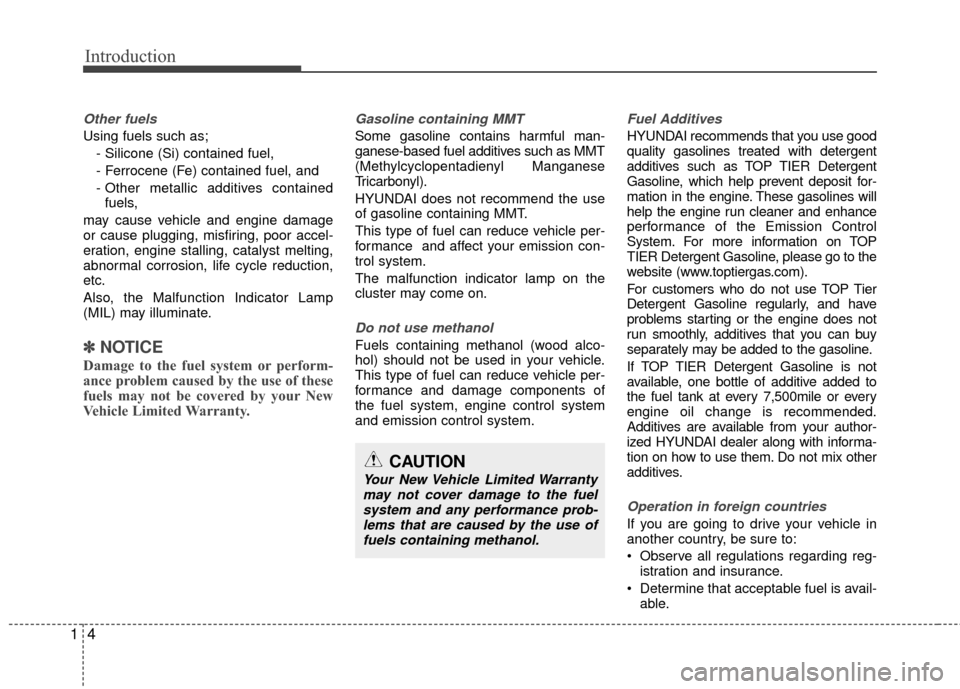
Introduction
41
Other fuels
Using fuels such as;- Silicone (Si) contained fuel,
- Ferrocene (Fe) contained fuel, and
- Other metallic additives containedfuels,
may cause vehicle and engine damage
or cause plugging, misfiring, poor accel-
eration, engine stalling, catalyst melting,
abnormal corrosion, life cycle reduction,
etc.
Also, the Malfunction Indicator Lamp
(MIL) may illuminate.
✽ ✽ NOTICE
Damage to the fuel system or perform-
ance problem caused by the use of these
fuels may not be covered by your New
Vehicle Limited Warranty.
Gasoline containing MMT
Some gasoline contains harmful man-
ganese-based fuel additives such as MMT
(Methylcyclopentadienyl Manganese
Tricarbonyl).
HYUNDAI does not recommend the use
of gasoline containing MMT.
This type of fuel can reduce vehicle per-
formance and affect your emission con-
trol system.
The malfunction indicator lamp on the
cluster may come on.
Do not use methanol
Fuels containing methanol (wood alco-
hol) should not be used in your vehicle.
This type of fuel can reduce vehicle per-
formance and damage components of
the fuel system, engine control system
and emission control system.
Fuel Additives
HYUNDAI recommends that you use good
quality gasolines treated with detergent
additives such as TOP TIER Detergent
Gasoline, which help prevent deposit for-
mation in the engine. These gasolines will
help the engine run cleaner and enhance
performance of the Emission Control
System. For more information on TOP
TIER Detergent Gasoline, please go to the
website (www.toptiergas.com).
For customers who do not use TOP Tier
Detergent Gasoline regularly, and have
problems starting or the engine does not
run smoothly, additives that you can buy
separately may be added to the gasoline.
If TOP TIER Detergent Gasoline is not
available, one bottle of additive added to
the fuel tank at every 7,500mile or every
engine oil change is recommended.
Additives are available from your author-
ized HYUNDAI dealer along with informa-
tion on how to use them. Do not mix other
additives.
Operation in foreign countries
If you are going to drive your vehicle in
another country, be sure to:
Observe all regulations regarding reg-
istration and insurance.
Determine that acceptable fuel is avail- able.
CAUTION
Your New Vehicle Limited Warrantymay not cover damage to the fuelsystem and any performance prob-lems that are caused by the use offuels containing methanol.
Page 12 of 456
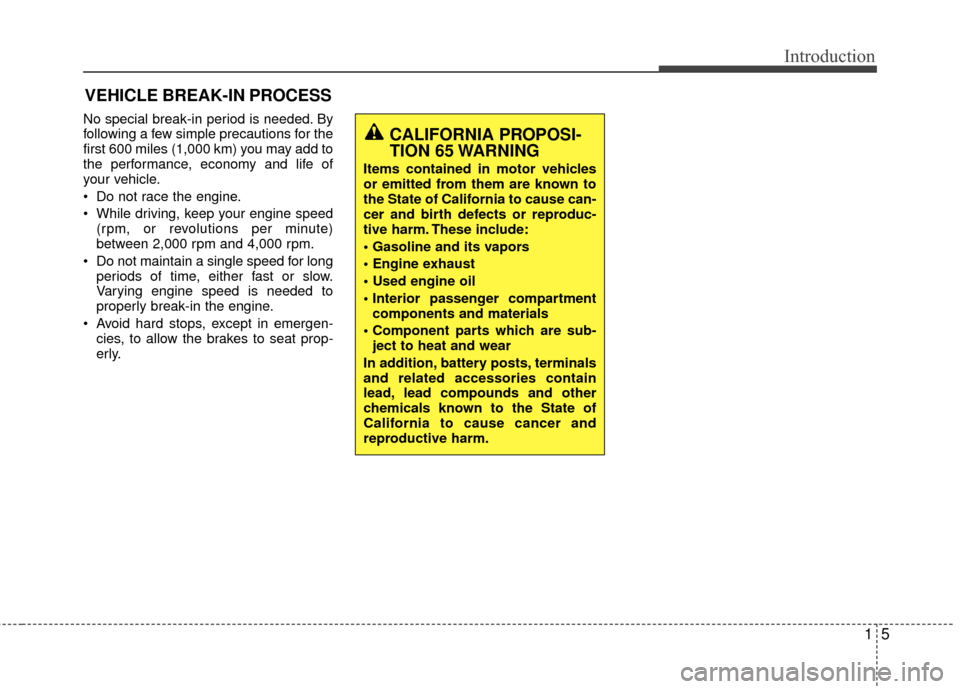
15
Introduction
No special break-in period is needed. By
following a few simple precautions for the
first 600 miles (1,000 km) you may add to
the performance, economy and life of
your vehicle.
Do not race the engine.
While driving, keep your engine speed(rpm, or revolutions per minute)
between 2,000 rpm and 4,000 rpm.
Do not maintain a single speed for long periods of time, either fast or slow.
Varying engine speed is needed to
properly break-in the engine.
Avoid hard stops, except in emergen- cies, to allow the brakes to seat prop-
erly.
VEHICLE BREAK-IN PROCESS
CALIFORNIA PROPOSI-
TION 65 WARNING
Items contained in motor vehicles
or emitted from them are known to
the State of California to cause can-
cer and birth defects or reproduc-
tive harm. These include:
components and materials
ject to heat and wear
In addition, battery posts, terminals
and related accessories contain
lead, lead compounds and other
chemicals known to the State of
California to cause cancer and
reproductive harm.
Page 13 of 456
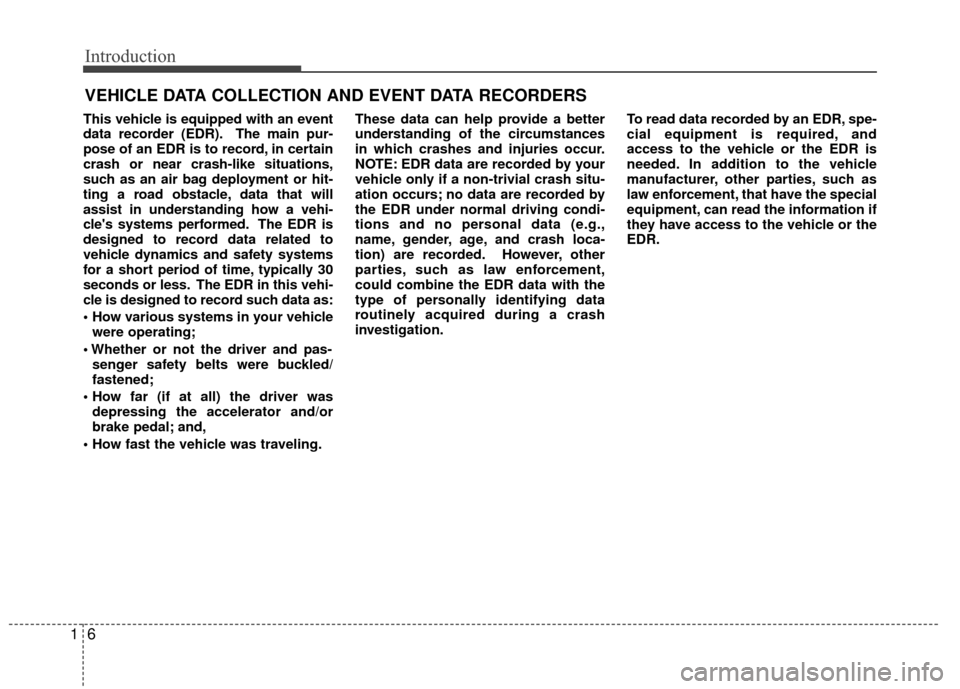
Introduction
61
This vehicle is equipped with an event
data recorder (EDR). The main pur-
pose of an EDR is to record, in certain
crash or near crash-like situations,
such as an air bag deployment or hit-
ting a road obstacle, data that will
assist in understanding how a vehi-
cle's systems performed. The EDR is
designed to record data related to
vehicle dynamics and safety systems
for a short period of time, typically 30
seconds or less. The EDR in this vehi-
cle is designed to record such data as:
were operating;
senger safety belts were buckled/
fastened;
depressing the accelerator and/or
brake pedal; and,
These data can help provide a better
understanding of the circumstances
in which crashes and injuries occur.
NOTE: EDR data are recorded by your
vehicle only if a non-trivial crash situ-
ation occurs; no data are recorded by
the EDR under normal driving condi-
tions and no personal data (e.g.,
name, gender, age, and crash loca-
tion) are recorded. However, other
parties, such as law enforcement,
could combine the EDR data with the
type of personally identifying data
routinely acquired during a crash
investigation.
To read data recorded by an EDR, spe-
cial equipment is required, and
access to the vehicle or the EDR is
needed. In addition to the vehicle
manufacturer, other parties, such as
law enforcement, that have the special
equipment, can read the information if
they have access to the vehicle or the
EDR.
VEHICLE DATA COLLECTION AND EVENT DATA RECORDERS
Page 14 of 456

2
Interior overview / 2-2
Instrument panel overview / 2-3
Engine compartment / 2-4
Your vehicle at a glance
Page 15 of 456
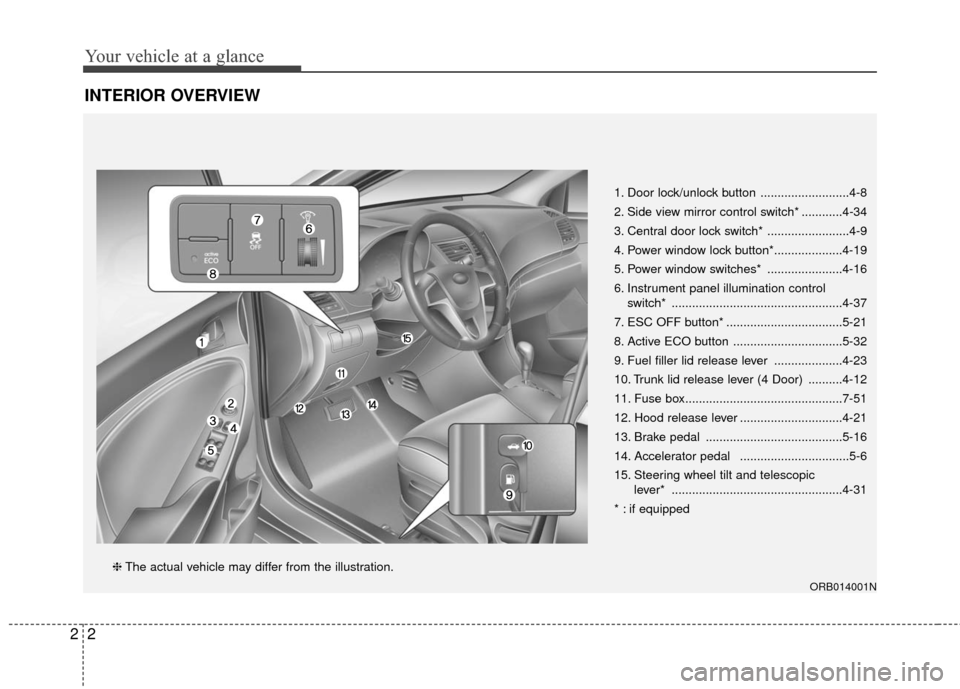
Your vehicle at a glance
22
INTERIOR OVERVIEW
1. Door lock/unlock button ..........................4-8
2. Side view mirror control switch* ............4-34
3. Central door lock switch* ........................4-9
4. Power window lock button*....................4-19
5. Power window switches* ......................4-16
6. Instrument panel illumination control switch* ..................................................4-37
7. ESC OFF button* ..................................5-21
8. Active ECO button ................................5-32
9. Fuel filler lid release lever ....................4-23
10. Trunk lid release lever (4 Door) ..........4-12
11. Fuse box..............................................7-51
12. Hood release lever ..............................4-21
13. Brake pedal ........................................5-16
14. Accelerator pedal ................................5-6
15. Steering wheel tilt and telescopic lever* ..................................................4-31
* : if equipped
❈ The actual vehicle may differ from the illustration.
ORB014001N
Page 16 of 456
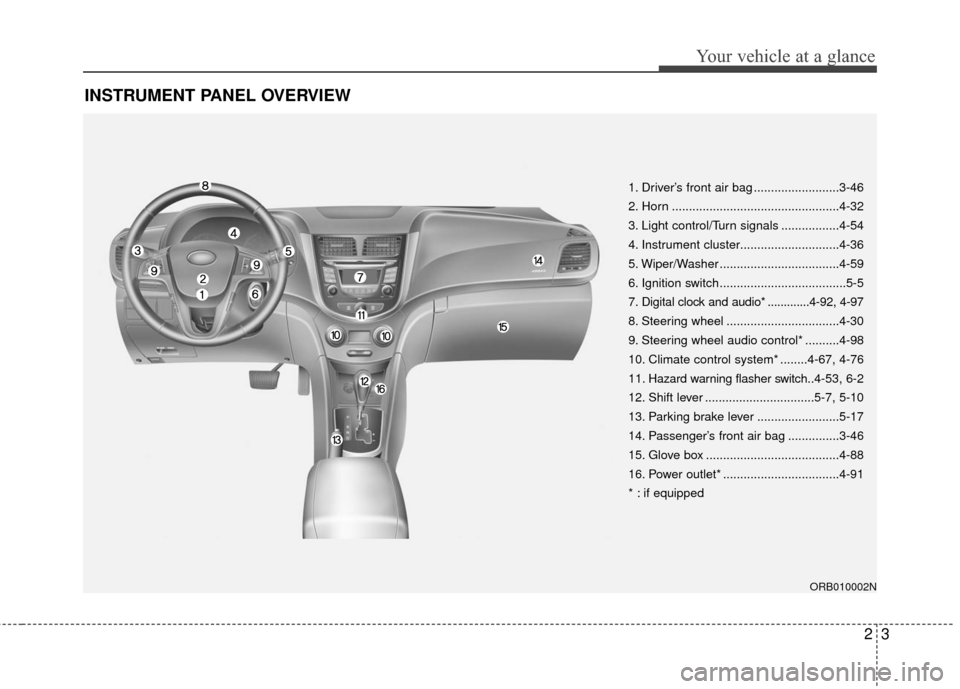
23
Your vehicle at a glance
INSTRUMENT PANEL OVERVIEW
1. Driver’s front air bag .........................3-46
2. Horn .................................................4-32
3. Light control/Turn signals .................4-54
4. Instrument cluster.............................4-36
5. Wiper/Washer ...................................4-59
6. Ignition switch .....................................5-5
7. Digital clock and audio* .............4-92, 4-97
8. Steering wheel .................................4-30
9. Steering wheel audio control* ..........4-98
10. Climate control system* ........4-67, 4-76
11. Hazard warning flasher switch..4-53, 6-2
12. Shift lever ................................5-7, 5-10
13. Parking brake lever ........................5-17
14. Passenger’s front air bag ...............3-46
15. Glove box .......................................4-88
16. Power outlet* ..................................4-91
* : if equipped
ORB010002N
Page 17 of 456
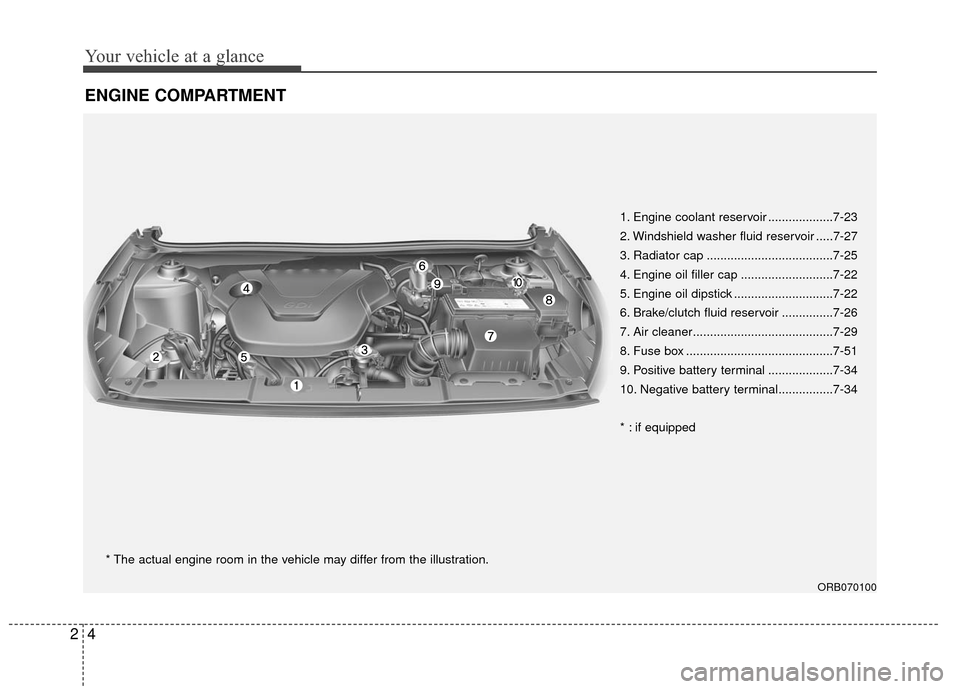
Your vehicle at a glance
42
ENGINE COMPARTMENT
ORB070100
* The actual engine room in the vehicle may differ from the illustration.1. Engine coolant reservoir ...................7-23
2. Windshield washer fluid reservoir .....7-27
3. Radiator cap .....................................7-25
4. Engine oil filler cap ...........................7-22
5. Engine oil dipstick .............................7-22
6. Brake/clutch fluid reservoir ...............7-26
7. Air cleaner.........................................7-29
8. Fuse box ...........................................7-51
9. Positive battery terminal ...................7-34
10. Negative battery terminal................7-34
* : if equipped
Page 18 of 456
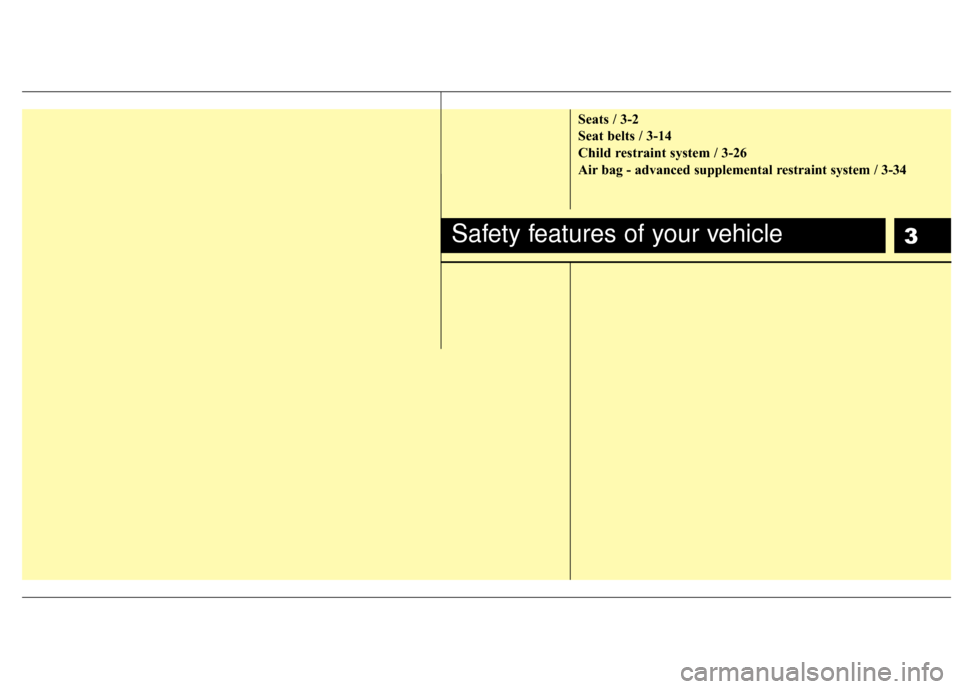
3
Seats / 3-2
Seat belts / 3-14
Child restraint system / 3-26
Air bag - advanced supplemental restraint system / 3-34
Safety features of your vehicle
Page 19 of 456
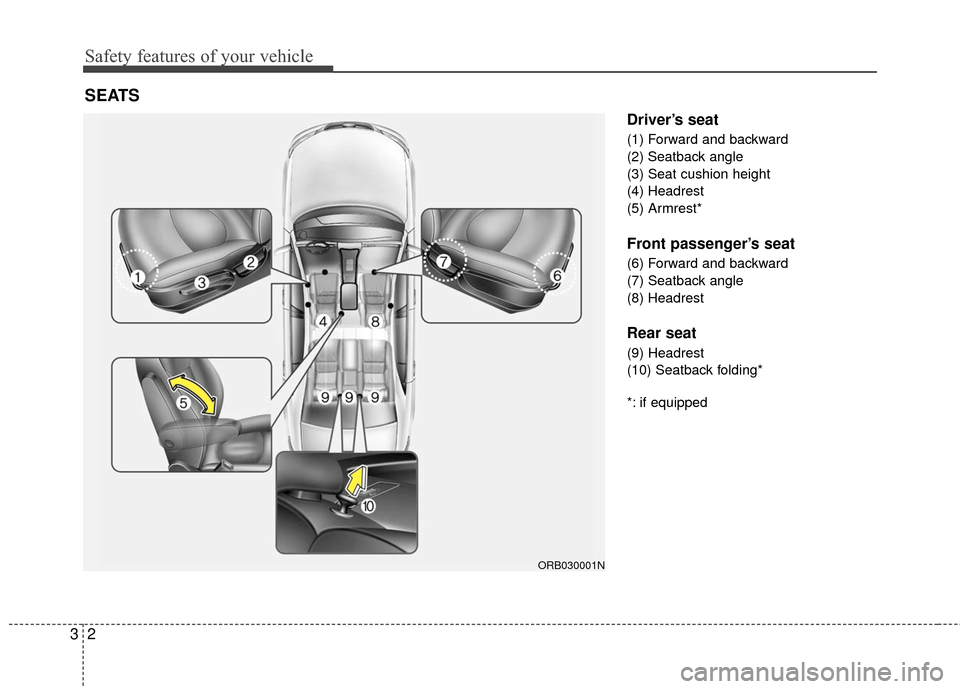
Safety features of your vehicle
23
Driver’s seat
(1) Forward and backward
(2) Seatback angle
(3) Seat cushion height
(4) Headrest
(5) Armrest*
Front passenger’s seat
(6) Forward and backward
(7) Seatback angle
(8) Headrest
Rear seat
(9) Headrest
(10) Seatback folding*
*: if equipped
SEATS
ORB030001N
Page 20 of 456

33
Safety features of your vehicle
WARNING- Driver’s seat
Never attempt to adjust the seatwhile the vehicle is moving. This
could result in loss of control,
and an accident causing death,
serious injury, or property dam-
age.
Do not allow anything to interfere with the normal position of the
seatback. Storing items against a
seatback or in any other way
interfering with proper locking of
a seatback could result in serious
or fatal injury in a sudden stop or
collision.
seatback upright and the lap por-
tion of the seat belt snug and low
across the hips. This is the best
position to protect you in case of
an accident.
In order to avoid unnecessary and perhaps severe air bag
injuries, always sit as far back as
possible from the steering wheel
while maintaining comfortable
control of the vehicle. We recom-
mend that your chest be at least
10 inches (250 mm) away from
the steering wheel.
WARNING- Loose objects
Loose objects in the driver’s foot
area could interfere with the opera-
tion of the foot pedals, possibly
causing an accident. Do not place
anything under the front seats.
WARNING- Driver respon-
sibility for passengers
Riding in a vehicle with the seat-
back reclined could lead to serious
or fatal injury in an accident. If a
seat is reclined during an accident,
the occupant’s hips may slide
under the lap portion of the seat
belt, applying great force to the
unprotected abdomen. Serious or
fatal internal injuries could result.
The driver must advise the passen-
ger to keep the seatback in an
upright position whenever the vehi-
cle is in motion.
WARNING - Uprighting
seat
When you return the seatback to its
upright position, hold the seatback
and return it slowly and be sure
there are no other occupants
around the seat. If the seatback is
returned without being held and
controlled, the back of the seat
could spring forward resulting in
accidental injury to a person struck
by the seatback.
WARNING
Do not use a sitting cushion that
reduces friction between the seat
and passenger. The passenger's
hips may slide under the lap por-
tion of the seat belt during an acci-
dent or a sudden stop. Serious or
fatal internal injuries could result
because the seat belt can't operate
normally.